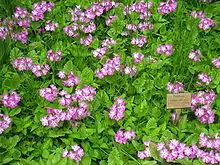Primula sieboldii
Primula sieboldii, the Japanese primrose, is a species of primrose that is endemic to East Asia. The species goes by common names such as Siebold's primrose, cherry blossom primrose, Japanese woodland primrose[2] Snowflake, Geisha girl, Madam butterfly[3] and the Japanese primrose which also applies to the related species Primula japonica.
| Primula sieboldii | |
|---|---|
 | |
| Scientific classification | |
| Kingdom: | Plantae |
| Clade: | Tracheophytes |
| Clade: | Angiosperms |
| Clade: | Eudicots |
| Clade: | Asterids |
| Order: | Ericales |
| Family: | Primulaceae |
| Genus: | Primula |
| Species: | P. sieboldii |
| Binomial name | |
| Primula sieboldii | |
| Synonyms[1] | |
| |
Origin
The species was first described by Charles Jacques Édouard Morren and was named after Philipp Franz von Siebold, a German physician.[1]
Description
The plant is perennial with fibrous roots. Its leaves are arranged into a rosette while its petiole is hairy and is 3.5–12 centimetres (1.4–4.7 in) long. It has an ovate blade that is also hairy, but is cordate at the base and is both crenate and round at the apex. The species have 10–25 centimetres (3.9–9.8 in) tall scapes and have an inflorescence which has an umbel of 5-15 flowers. The sepal is bell-shaped and is 0.7 centimetres (0.28 in) long with spreading lobes that are lanccolated.[1]
Distribution
Primula sieboldii is an ornamental plant which grows in wet areas and forests in China, Japan, Korea, and Russia.[1]
References
- Christophe Wiart (2012). Medicinal Plants of China, Korea, and Japan: Bioresources for Tomorrow’s Drugs and Cosmetics. CRC Press. p. 306. ISBN 978-1-4398-9911-3.
- Jodie Mitchell; Lynne Lawson (2016). The Plant Lover's Guide to Primulas. p. 134.
- John Richards (2002) [1993]. Primula. Pavilion Books Company Ltd. p. 232. ISBN 978-1-8499-4241-6.